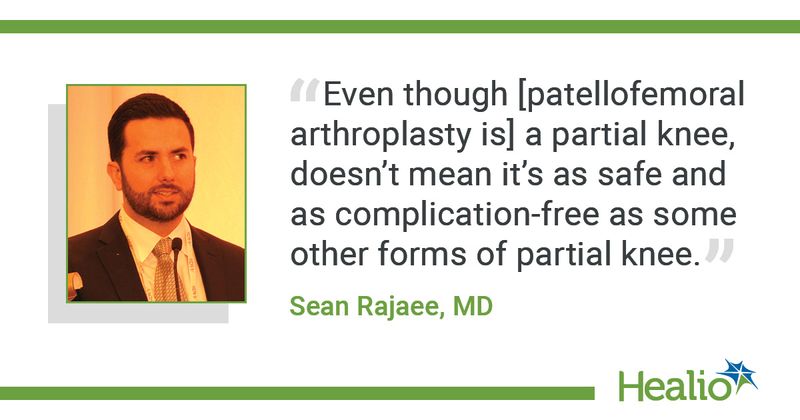Patellofemoral arthroplasty may have complication profile that is more similar to TKA
Click Here to Manage Email Alerts
LAS VEGAS — Results presented at the American Academy of Orthopaedic Surgeons Annual Meeting showed patellofemoral arthroplasty carried higher 2-year revision and wound complication rates than total knee arthroplasty.
“Even though [patellofemoral arthroplasty is] a partial knee, doesn’t mean it’s as safe and as complication-free as some other forms of partial knee,” Sean Rajaee, MD, adult reconstruction orthopedic surgeon at Cedars-Sinai Medical Center, said in his presentation here. “Ultimately, I think patient selection for patellofemoral arthroplasty is of paramount importance.”

Using the PearlDiver database, Rajaee and colleagues reviewed 2-year all-cause revision rates and rates of surgical site infection requiring surgery, wound complications and manipulation under anesthesia among patients with primary osteoarthritis who underwent either patellofemoral arthroplasty, TKA or unicompartmental arthroplasty.
“Looking at patient characteristics, overall it was similar; however, patellofemoral patients, as expected, were a little bit younger with their age being around 58 [years] compared to total knee arthroplasty patients being older in the mid-60s,” Rajaee said.
He added there were a higher proportion of female patients and a slightly increased percentage of patients who smoked or used tobacco in the patellofemoral arthroplasty group. However, patients in the patellofemoral arthroplasty group had less instances of coronary artery disease, chronic kidney disease and diabetes.
“At 2 years, the revision rate for patellofemoral arthroplasty was 7% and that was remarkably higher than the 2-year revision rate that was identified for total knee arthroplasty patients and unicompartmental arthroplasty patients,” Rajaee said.
He noted patients in the patellofemoral arthroplasty group had a 2.4% rate of wound complications, which was statistically significant when compared with the TKA group and the unicompartmental arthroplasty group. Rajaee added similar trends were seen with surgical site infections.
“Manipulation under anesthesia is not so commonly performed in these types of procedures, but the rate was similar for total knee arthroplasty and patellofemoral arthroplasty,” Rajaee said.

